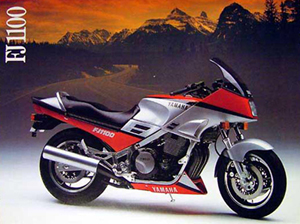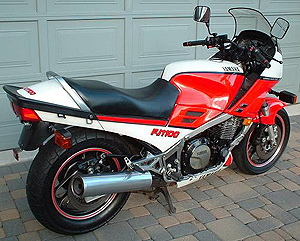Services |
|
| |
|
Showcase |
< |
Motorcycle
Tours |
< |
Parts
Suppliers |
< |
Insurance |
< |
Accessories |
< |
|
< |
Schools |
< |
Transportation |
< |
|
|
|
|
| |
|
|
 |
In
1984, Yamaha reentered the super-bike fray after
years of neutrality. The long-awaited FJ1100 was
big, fast and refined the first open class street
bike from Yamaha to be taken seriously, an immediate
force to be reckoned with by the other factories.
There were faster, sharper bikes that year, but
none of them had the FJ’s whole cloth compet-ence.
The Yamaha embodies a classic balance of comfort |
| and
performance that has lengthened its lifespan far
beyond that of the other open-class soldiers it
once fought, which have long since faded away.Since
1984 the deck has been shuffled more than once:
positions and players have changed. In the natural
progression of things, the FJ has gone from warrior
to elder statesman. Pulled from the U.S. market
last year due to a surfeit of unsold 87 models,
and now returned from exile, the FJ is no longer
the flagship of Yamaha’s engineering acumen.
Instead, Yamaha has sharpened the FJ's focus on
the sport-touring market, where it now competes
with such mach-ines as BMW's K100RS, Suzuki's 1100
Katana and Kawasaki's ZX-10. Other liter-class motorcycles
make more peak horsepower and handle better than
the FJ,but it has taken on a smooth, gray-at-the-temples
character those adenoidal upstarts lack.The Yamaha's
beauty becomes |
| apparent
as its odometer racks up miles. Many motorcyclists
will be hard-pressed to find a more comfortable
bike for a rider and passenger, short of a fulldress
tourer. It's still one of the hardest acceler-ating
motorcycles around, and well considered suspension
upgrades have seen to it that the FJ's legs have
more than enough life to run with the rookies. In
fact, the only things that stop this bike from still
being the Superbike King are Yamaha's own |
|
| FZR1000
and Suzuki's GSXR-1100. But those are birds of a
much different feather, with more emphasis on high
performance and less on utility. The tightest of
them (the FZR) weighs 66 pounds less than the FJ.
Their more modern engines make greater peak power
that results in higher top speeds, and they have
more advanced |
 |
chassis.
But strap your significant other to either of
those brutes for more than 50 miles and it's only
a matter of time before papers
are served.The FJ can still bang fairings with
the youngsters, up to a point beyond the limits
of most riders, but experience has taught it certain
things that come with middle age.It has learned
to, |
|
well, prolong the act of riding. Rather than going
at a full-throttle, toe-curling sweat to completion
of an outing in the shortest possible time, the
FJ wants to satisfy its rider over a period of hours,
over hundreds of miles. In fact, long-distance riders
not of the bolt upright, full-dress
school may find the FJ more comfortable than the
land yachts. Set full soft, it rivals their cushy
rides, easily absorbing a variety of bumps, holes
and ripples. The fairing and windscreen - 50mm taller
and 60mm wider this |
|
|
| year,
with bulges to keep windblast off the rider's hands
- encapsulate an average-height rider's torso in
still air.The seat is thick, wide, and feels lower
than its 30.1-inch height. Wide and high clip-ons
cant the rider slightly forward, while rubber-mounted
footpegs place his feet slightly to the rear. Overall,
the FJ offers splendid accommodations. In keeping
with the bike's enhanced emphasis on long-haul comfort,
backseat riders have been granted rubber-mounted
footpegs and a less pronounced slope to their portion
of the saddle. One veteran passenger gave the |

|
Yamaha
high marks, faulting it only for a still-too-steep
perch which slid her insist-ently forward. In
the sport-touring venue, the FJ's weight and size
hurt it not at all. Over a long haul the bike's
mass makes it feel like a 7-series BMW automobile
- totally relentless and unruffled, solid as a
very supple rock, the smoothest of engines begging
for more throttle. The Porsche-like dashboard
further reinforces the FJ's |
|
image
as a Euro-cruiser. Three large instruments - a
tachometer surrounded by a speedometer and a fuel
gauge - light up a warm and readable orange at
night. There's also an easily accessible fuel-reserve
switch in the left-side fairing inner. A digital
clock keeps track of the time; not such a small
thing when you need to know but your watch is
buried under your left sleeve and gauntlet. Remove
the bodywork, and it reassembles with solid, logical
precision. Everything about the FJ says function
without frillery. Here we are. Let's you and me
snort some road. Fuel capacity of 5.8 gallons
gives the bike a range of about 250 miles, longer
than that of most riders. Such compelling
power, combined with almost armchair-like comfort,
makes it hard to fault the FJ in its role as traffic-blaster
and road-swallower par excellence. Recruit a passenger,
strap on some soft luggage, and try to conceive
of a more pleasant long-distance, high-performance
conveyance.
Time has been good to the FJ. It has fought its
battles, and gallantly, but it is not nearly ready
for retirement. The younger lions claw and bite
harder, and their lifespans will be short if history
is any indication. Yamaha's FJ1200 is a survivor
because it is an intelligent machine, one with
wisdom tempered by fire. Rather than doing one
thing excellently, it does everything very well.
|
|
Partially reprinted from Cycle Magazine, July
1989.
|
The
Canadian Classic Bike Exchange
Entire contents Copyright © 2005 All rights reserved.
|
|


|